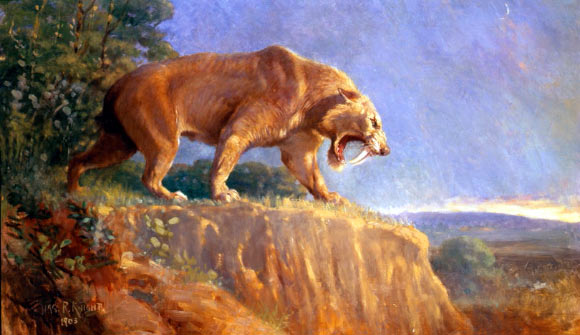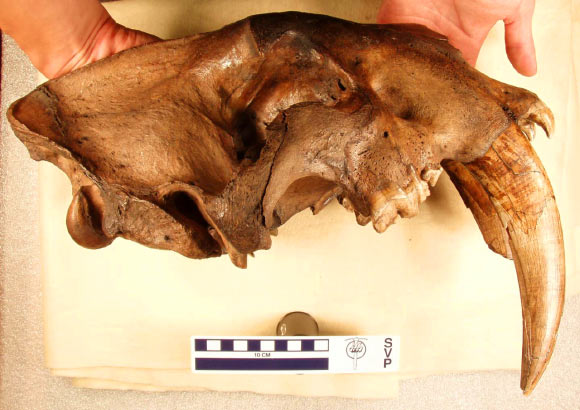A new study reported in the journal PLoS ONE shows that the teeth of the fearsome saber-toothed cat (Smilodon fatalis) fully emerged later in life than those of modern big cats, but grew at a rate about double that of their living relatives.

The saber-toothed cat (Smilodon sp.). Image credit: Charles R. Knight.
The saber-toothed cat lived in the Americas until going extinct about 10,000 years ago. The cats are famous for their protruding canines, which could grow to be about 7 inches (18 cm) long. Although fossils are available to paleontologists, very little is known about the ages at which the animals reached key developmental stages.
“Timing of development is critical for many aspects of vertebrate ecology and evolution. Changes in the timing of life-history events can have major effects on an organism’s adult features and final appearance,” said study co-author Dr Robert Feranec of the New York State Museum. “For extinct species, we can usually only determine the relative sequence of developmental events.”

“For predators such as big cats, an important determinant of an individual’s full hunting ability is the time required to grow their weapons – their teeth. This is especially crucial for understanding saber-toothed predators such as Smilodon,” added co-author Dr Jack Tseng from the American Museum of Natural History.
Using saber-toothed cat fossils recovered from Rancho La Brea in Los Angeles, the scientists combined data from stable oxygen isotope analyses, micro-computed tomography, and previous studies to establish the eruption rate for the saber-toothed cat’s permanent upper canines and to calculate the timing of other growth events.

This fossilized jaw of an adult saber-toothed cat (Smilodon fatalis) shows the fully erupted canine. Image credit: Jack Tseng / American Museum of Natural History.
The scientists estimate that the permanent dentition of saber-toothed cats was fully erupted by 14 to 22 months, with the exception of the upper canines.
These weren’t fully developed until about 3 years of age, which is delayed in comparison to similar-sized living members of the cat family.

The eruption rate of the saber-toothed cat’s permanent upper canines was 6 mm per month, double the growth rate of African lion’s teeth.
The paleontologists suggest that the technique used in the study could be applied to a variety of extinct species to better understand the manner and rate by which different animals grew, for example, by looking at the tusks of extinct elephants or marine mammals.
“Despite having canine crown heights that were more than twice those of the lion, it didn’t require twice as much time to develop its canines,” said study first author Dr Aleksander Wysocki of Clemson University.
Source: sci.news








